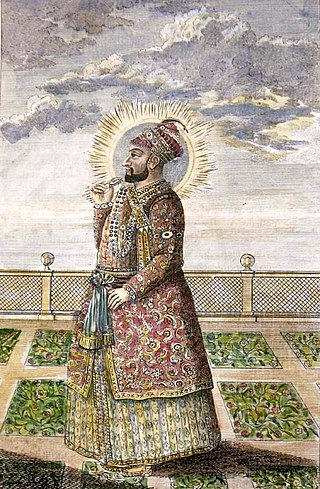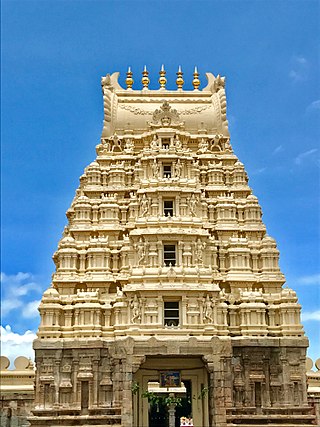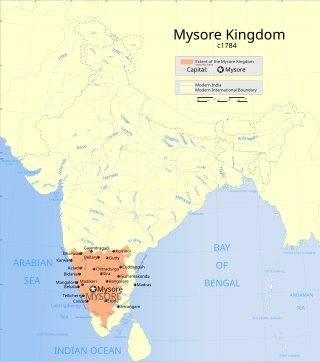Related Research Articles

Tipu Sultan commonly referred to as Sher-e-Mysore or "Tiger of Mysore",was a ruler of the Kingdom of Mysore based in South India. He was a pioneer of rocket artillery. He expanded the iron-cased Mysorean rockets and commissioned the military manual Fathul Mujahidin. The economy of Mysore reached a zenith during his reign. He deployed rockets against advances of British forces and their allies during the Anglo-Mysore Wars,including the Battle of Pollilur and Siege of Srirangapatna.

Hyder Ali was the Sultan and de facto ruler of the Kingdom of Mysore in southern India. Born as Hyder Ali,he distinguished himself as a soldier,eventually drawing the attention of Mysore's rulers. Rising to the post of Dalavayi (commander-in-chief) to Krishnaraja Wodeyar II,he came to dominate the titular monarch and the Mysore government. He became the de facto ruler,King of Mysore as Sarvadhikari by 1761. During intermittent conflicts against the East India Company during the First and Second Anglo–Mysore Wars,Hyder Ali was the military leader.

Srirangapatna or Srirangapattana is a town and headquarters of one of the seven Taluks of Mandya district,in the Indian State of Karnataka. It gets its name from the Ranganthaswamy temple consecrated around 984 CE. Later,under the British rule,the city was renamed to Seringapatam. Located near the city of Mandya,it is of religious,cultural and historic importance.

The Maratha Confederacy,also referred to as the Maratha Empire,was an early modern polity in the Indian subcontinent. It comprised the realms of the Peshwa and four major independent Maratha states often subordinate to the former. It was established in 1674 with the coronation of Shivaji as the Maratha Chhatrapati and recognised by Emperor Bahadur Shah I as a tributary state in 1707 following a prolonged rebellion. Following this,the Marathas continued to recognise the Mughal emperor as their nominal suzerain,similar to other contemporary Indian entities,though in practice,imperial politics at Delhi were largely influenced by the Marathas between 1737 and 1803.

The Kingdom of Mysore was a geopolitical realm in southern India founded in around 1399 in the vicinity of the modern-day city of Mysore and prevailed until 1950. The territorial boundaries and the form of government transmuted substantially throughout the kingdom's lifetime. While originally a feudal vassal under the Vijayanagara Empire,it became a princely state in British Raj from 1799 to 1947,marked in-between by major political changes.

The Fourth Anglo-Mysore War was a conflict in South India between the Kingdom of Mysore against the British East India Company and the Hyderabad Deccan in 1798–99.
Rao is a title and a surname native to India. It is used mostly in states of Andhra Pradesh,Gujarat,Haryana,Karnataka,Maharashtra,Rajasthan,and Telangana.

Nana Fadnavis,born Balaji Janardan Bhanu,was a Maratha minister and statesman during the Peshwa administration in Pune,India. James Grant Duff states that he was called "the Maratha Machiavelli" by the Europeans.
The History of Karnataka goes back several millennia. Several great empires and dynasties have ruled over Karnataka and have contributed greatly to the history,culture and development of Karnataka as well as the entire Indian subcontinent. The Chindaka Nagas of central India Gangas,Rashtrakutas of Manyakheta,Chalukyas of Vengi,Yadava Dynasty of Devagiri were all of Kannada origin who later took to encouraging local languages.

The Sword of Tipu Sultan is an Indian historical drama that was first broadcast on the DD National in February 1990. Based on a novel by Bhagwan Gidwani,this drama is a fictional portrayal of the life and times of Tipu Sultan,the 18th century ruler of Mysore. The series was widely praised for its casting and grandeur.

Madhavrao II was the 12th Peshwa of the Maratha Confederacy,from his infancy. He was known as Sawai Madhav Rao or Madhav Rao Narayan. He was the posthumous son of Narayanrao Peshwa,murdered in 1773 on the orders of Raghunathrao. Madhavrao II was considered the legal heir,and was installed as Peshwa by the Treaty of Salbai in 1782 after First Anglo-Maratha War.
The Kingdom of Mysore was a kingdom in southern India traditionally believed to have been founded in 1399 in the region of the city of Mysore in Karnataka. For the most part,the Wodeyar dynasty ruled the southern Karnataka region until the kingdom united with the Dominion of India in 1947. During the kingdom's history,it went through various phases of administration,with increasing foreign influence from the eighteenth century.

KrishnacharyaPurnaiah,popularly known as DewanPurnaiah,was an Indian administrator,statesman,and military strategist who served as the first dewan of Mysore from 1782 to 1811. He was instrumental in the restoration of the rule of the Kingdom of Mysore to the Wadiyar dynasty. After the death of Tipu,he continued to advice Lakshmi Devi,the queen regent to the newly installed monarch Krishnaraja Wodeyar III.
The captivity of Kodavas (Coorgis) at Seringapatam was the period of capture,deportation,and imprisonment of Kodava Takk speaking kodavas who rebelled against Tippu Sultan,the de facto ruler of the Kingdom of Mysore,they (60,000-70,000) were caught during a number of attempts to suppress their rebellion in the 1780s.
Mysorean rockets were an Indian military weapon. The iron-cased rockets were successfully deployed for military use. They were the first successful iron-cased rockets,developed in the late 18th century in the Kingdom of Mysore under the rule of King Hyder Ali. The Mysorean army,under King Hyder Ali and his son King Tipu Sultan,used the rockets effectively against the British East India Company during the 1780s and 1790s. According to James Forbes Marathas also used iron-encased rockets in their battles. Their conflicts with the company exposed the British to this technology further,which was then used to advance European rocketry with the development of the Congreve rocket in 1805.
The dewan of Mysore was the de facto chief executive officer of the Government of Mysore,ex officio chairman of the Dewan's Council,and the prime minister and royal adviser to the maharaja of Mysore. The role evolved in title and duties since the foundation of the fiefdom of Mysore in 1350 and its proper reformation into a kingdom in the following centuries until the kingdom's full abolishment in 1950. With the constitution of India into a republic in 1950,the position was replaced by Chief Minister of Mysore.

The Lakshmikanta Temple is a Hindu (Vaishnava) temple in Kalale,a village in the Nanjangud taluk of the Mysore district,Karnataka state,India. The temple dates back at least to the early 18th century and is built in typical dravidian style. The temple is a protected monument under the Karnataka state division of the Archaeological Survey of India.

Madhva Brahmins,are communities of Hindus from the Brahmin caste in India,who follow Sadh Vaishnavism and Dvaita philosophy propounded by Madhvacharya. They are found mostly in the Indian states of Karnataka,Maharashtra,Goa,Tamil Nadu,Kerala,Telangana and Andhra Pradesh.

Chamarajapuram is one of the earliest settlements and localities in Mysore,Karnataka,India,located in the centre of the city. Initially an agraharam inhabited by the Mysore nobility,parts of it were later allotted other local dwellers as well.

Sham Raj I;born as Renuka Das Bhalerao,popularly known as Raja Sham Raj Rai Rayan,was a general,a statesman,and an Indian noble who served as Prime Minister of Hyderabad. He is also known as Raja Shan Rai Rayan Renuka Das.
References
- ↑ Kadati Reddera Basavaraja (1984). History and Culture of Karnataka: Early Times to Unification. Chalukya Publications. p. 306.
- ↑ Tipu Sultan: The Tiger of Mysore. Directorate of Archaeology and Museums, Government of Karnataka. 2010. p. 375.